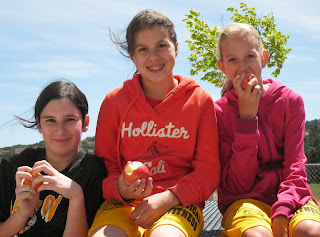This question comes up a lot when I work with families.
How much exercise do our kids really need?
Here are the National Guidelines:
Children and adolescents should have 60 minutes =(1 hour)
or more
of physical activity DAILY!
- Aerobic: Most of the 60 or more minutes a day should be either moderate- or vigorous-intensity aerobic physical activity and should include vigorous-intensity physical activity at least 3 days a week
- Muscle-strengthening: As part of their 60 or more minutes of daily physical activity, children and adolescents should include muscle-strengthening physical activity on at least 3 days of the week.
- Bone-strengthening: As part of their 60 or more minutes of daily physical activity, children and adolescents should include bone-strengthening physical activity on at least 3 days of the week.
- Source: U.S. Department of Health and Human Services. Physical Activity Guidelines for Americans. Washington, DC: U.S. Department of Health and Human Services; 2008.
When I work with families, I ask them to focus on increasing the amount of physical activity outside of the school day. Here are some ideas:
- Walk or bike to school
- If school is too far, drive part way and walk the rest of the way
- Enroll in organized sport programs (there are so many levels now from non-competitive to highly competitive)
- City Parks and Recreation departments have great programs that are reasonable priced! This is great way to try something new...
- Talk to your school PTA about a walking or running club that takes place before school. Incentive kids for every lap or mile.
- Make family time ACTIVE! Go for a hike, bike ride or walk in the neighborhood.
- Suggest non-traditional sports like fencing, rock climbing, ice skating and hockey.
- Consider buying an inexpensive pedometer that records step and encourage them to work up to 10,000 steps a day.
Reminders:
1) 60 minutes a day is the goal. It is okay if you child is not htere yet - encourage them to start at 20 minutes a day for 7 days, then 30, then 40 etc.
Also, exercise can take place in 10 minute increments. This makes it easier to achieve a goal
2) Exercise is not an option. This is what I say to my kids and my students "Which activity are you going to do" or "What are you going to do to get your exercise today?"







